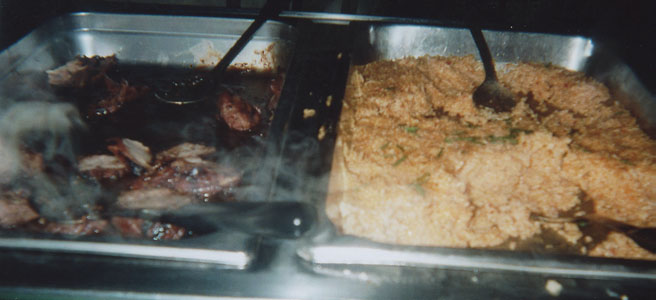 When you steam food, you preserve the texture and vitamins, but you make it really hot. If you steam too long, it will wilt or get soggy; if you don't steam enough, part of it remains cold.
When you steam food, you preserve the texture and vitamins, but you make it really hot. If you steam too long, it will wilt or get soggy; if you don't steam enough, part of it remains cold. Dramatic Structure is the organization of conflict between characters in their world. Cut, carve and cook it, simmer, sauté, bake, broil, boil, or serve your meat raw and bleeding. Stay here for the mountain versus the circle, but for Boolean layers, caravan tales, and other paradigms influenced by twentieth century physics, and how world cultures experience time and space differently go to Part Four.
 When you steam food, you preserve the texture and vitamins, but you make it really hot. If you steam too long, it will wilt or get soggy; if you don't steam enough, part of it remains cold.
When you steam food, you preserve the texture and vitamins, but you make it really hot. If you steam too long, it will wilt or get soggy; if you don't steam enough, part of it remains cold. Coffee benefits from the steaming process and sometimes makes us think more sharply.
Drama began from our love and need for imitation, harmony and rhythm. Tragedy is an imitation of characters of noble birth and comedy of inferior types whose flaws are so exaggerated and real that we can laugh at them. Tragedy is an imitation of an action that is serious, complete and of a certain magnitude, in language embellished with each kind of ornament, through pity and fear effecting the proper purgation of the audience's emotions.Pity is aroused by unmerited misfortune; fear by the misfortune of a man like ourselves. Every tragedy must have six parts: Plot, Character, Diction, Thought, Spectacle, Song. Aristotle feels plot is more important than character because the most beautiful colors, laid on confusedly, will not give as much pleasure as the chalk outline of a portrait. Do you agree? Spectacle is the least important. Diction involves the delivery of words that are either current, or strange, or metaphorical, or ornamental, or newly-coined, or lengthened, or contracted, or altered. The perfection of style is to be clear without being mean or too literal, vulgar, simplistic etc.
Aristotle disliked episodic drama: for tragedy to be worthwhile it had to be a well constructed story with a beginning, middle and end that proceeded from action to counteraction by necessity and probability. There is a strong connection between what he wanted from drama and what he wanted from rhetoric, although the purpose of tragedy is to purge the emotions. Tragedy must be simpler and more credible than comedy if it is to move us to tears rather than laugher. A simple plot is one which takes place without reversal or recognition. A complex plot has reversals and recognitions which should arise from the internal structure. The best form of recognition is coincident with reversal, as in OEDIPUS. Characters must be chosen in such a way that their actions raise the stakes of the drama. It's better to have family members kill each other than an enemy kill an enemy because then you can construct scenes that have the elements of betrayal, jealousy, fear, love etc. as well as anger. The DEUS EX MACHINA must only be employed for events external to the drama; the crisis/climax should arise of necessity from the inciting incident, just the way it's supposed to do in Hollywood screenplays. Every tragedy falls into two parts: complication and unravelling. Complication is every action that moves to the turning-point from good to bad fortune and unravelling is that which extends from the beginning of the change to the end.
An epic structure differs from a tragedy because it has a multiplicity of plots. Epic structure is similar to what we call narrative structure. However as poetry (Homer) it was usually written in the heroic measure. Alexander Pope satirized this form in his mock epic poem THE RAPE OF THE LOCK in the eighteenth century. Epic tales can be longer, more complicated, more irrational and fantastical because they are not confined to the stage.
In Western drama the most important thing is a hero who badly wants something he can't get; in world mythology, it is the call to adventure to undertake a journey, implying that there are archetypal forces even stronger than the hero's objective. The first is a paradigm of time, heightened by compressing events in space into a limited time span; while the second is a paradigm of space that takes the hero away from the Ordinary World to transform enough in the Special World so he can bring back an elixir to community. Return, resurrection, rescue, archetypes, threshold struggle are some of the terms pitted against plot points, throughlines, premises, reversals, crisis/climax/denouement. While high concept screenplays involve the community and transformative dramas develop character transformation, in the Campbell paradigm, the hero's transformation is a resurrection that brings the community full circle. Campbell's work is motivated by his spiritual search and his recording of stories that transcend the hero's objective to connect to a more universal truth. Many Western stories stay with the self, its foibles, flaws, frustrations, and final triumph in getting what it wants.
The French dramatist, Georges Polti, categorized 36 dramatic situations, that presumably encompass all the major conflicts between characters in drama. If you are basing your story on real life, and want to raise the stakes, you can use one or more of these situations to cook your characters.
Supplication
Crime Pursued by Vengeance
Vengeance Taken for Kindred upon Kindred
Pursuit
Disaster
Falling Prey to Cruelty or Misfortune
Revolt
Daring Enterprise
Abduction
The Enigma
Obtaining
Enmity of Kinsmen
Rivalry of Kinsmen
Murderous Adultery
Madness
Fatal Imprudence
Involuntary Crimes of Love
Slaying of a Kinsman Unrecognized
Self-sacrificing for an Ideal
Self-sacrifice for Kindred
All Sacrificed for a Passion
Necessity of Sacrificing Loved Ones
Rivalry of Superior and Inferior
Adultery
Crimes of Love
Discovery of the Dishonor of a Loved One
Obstacles to Love
An Enemy Loved
Ambition
Conflict with a God
Mistaken Jealousy
Erroneous Judgment
Remorse
Recovery of a Lost One
Loss of Loved Ones
Think of what steam does. It cooks the ingredients while maintaining their integrity. When you steam fish and vegetables, you eat fish and vegetables, not a casserole. 

 Fry-- fat and sizzling the American way. Avoid greasy plot points--make a plot point crispy like Southern fried chicken.
Fry-- fat and sizzling the American way. Avoid greasy plot points--make a plot point crispy like Southern fried chicken.  Fried food is a fast way to cook, one that allows you to see what you are doing, and to make fattening food crispy.
Fried food is a fast way to cook, one that allows you to see what you are doing, and to make fattening food crispy.  Bread is usually toasted to give it a crispy flavor, and then plastered with butter and jam, while indigenous cultures generally bake their bread. Pizza can be cooked in a microwave oven, which shortens the cooking time with infra-red waves.
Bread is usually toasted to give it a crispy flavor, and then plastered with butter and jam, while indigenous cultures generally bake their bread. Pizza can be cooked in a microwave oven, which shortens the cooking time with infra-red waves.  Americans don't want to wait too long for the action to begin. Laborous expositions bore them. Americans like to put fruits and vegetables into the blender, or make homogenized milk.
Americans don't want to wait too long for the action to begin. Laborous expositions bore them. Americans like to put fruits and vegetables into the blender, or make homogenized milk. For a culture that is made up of immigrants, Americans tend to homogenize their stories.
For a culture that is made up of immigrants, Americans tend to homogenize their stories.
 Or dice vegetables so they will have a uniform appearance. They like extreme temperature changes, freezing milk and cream into ice cream.
Or dice vegetables so they will have a uniform appearance. They like extreme temperature changes, freezing milk and cream into ice cream.
 Many Americans fry their veggies as well as their carbs and protein, making everything as fattening as possible. Yet, in one sense, they like their dramas lean and mean: a theme, a task, a team, a deadline, a competition, a consequence-- you're fired--but that can also be influenced by sequencing and plot complexity.
Many Americans fry their veggies as well as their carbs and protein, making everything as fattening as possible. Yet, in one sense, they like their dramas lean and mean: a theme, a task, a team, a deadline, a competition, a consequence-- you're fired--but that can also be influenced by sequencing and plot complexity.
Dramatic structure, how the conflict unfolds, is not the same as narrative structure, the sequence of events in time and space colored by the POV of the narrator. Dramatic structure is the conflict between protagonist and antagonists as they fight for their through-lines in response to the Central Dramatic Question, a visual paradigm similar to falling off a cliff from catalyst to commitment to confrontation to cataclysm to chaos, crisis, climax and conclusion, timed by plot points. Emotion is consummated in a catharsis.
Americans still find Aristotle useful now for his catharsis and definition of unities of space, time and action and priorities of plot, character, thought, diction, song, spectacle. Shakespeare is good for the gap between expectations and result, colored by the character's dilemma and necessity to choose, a sequence of choices, which reveals deep character. While Americans can't compete with Shakespeare's language, nor do they want to, they have the same epic sense of crisis and climax and its effect on the community. However, they tend to prefer transformational drama to a tragedy where the hero dies. The hero is often a commoner who makes good rather than an aristocrat who falls, reinforcing the democratic social system of American culture.
While the plot points are a paradigm mainly of time, the monomyth is a paradigm of space. The circular journey from ordinary to special world and back and the stages of this journey from call to adventure, to crossing the threshold, approaching the inmost cave, returning resurrected and getting or giving the elixir are similar to plot points except that the spatial aspects represent a circle rather than falling off a cliff, thereby making the set-up and conclusion a bit longer.
Just like argumentation, drama deals with controversy, conflict and conversion in a search for truth except that logical fallacies are glorified to heighten the flaws of the tragic or comic characters. Drama must combust space and time so deadlines, planting and payoff are necessary to heighten surprise and mystery, while irony can enhance suspense and make the audience feel smart. No matter how intricate and discipline the dramatic structure, if the emotions of pity, fear, laughter or lust are not elicited in the audience, then the structure will be more like a legal case than a drama that requires catharsis to transcend the paradigms, just as wonder must transcend prosody in poetry.
World of Time: Plot Points and the Central Dramatic Question-Catalyst, Commitment, Confrontation, Chaos, Crisis, Climax, Conclusion
World of Space: Campbell Paradigm, Ordinary and Special Worlds, Bore-dinary and Extraordinary, Call to Adventure, Crossing Thresholds, Meeting with the Mentor, Approach the Inmost Cave, Reward, Resurrection, Elixir
Critical Analyses of the Major Screenwriting Authorities
Syd Field's primary domain is logical and he made his rep as a problem-solver, a script doctor, who made screenwriting accessible and temptingly possible to millions of would-be writers so that Hollywood only produces 500 scripts among hundreds of thousands available. But his bias is clear: the lean, mean script that follows the Hollywood paradigm like a well-tuned racehorse, running to the climax through the plot points he made famous. But he has his bias: "the overall effect was really somewhat dull and boring. Basically talking heads. That 's not screenwriting. That's playriting." (5) I wonder if Shakespeare would have enjoyed being called a talking head. I wonder if Hollywood 's illiterate monosyllables will continue to permeate the global market in the twenty first century. But Field is comforting, helpful, the kind of guy one would run to for clarity, encouragement, and concrete tasks to get rid of writer's block.
Syd Field favors the transformative three act sturcture with clean, strong, convincing characters who have clear-cut dramatic needs. He hates ambiguity in screenwriting as much as George W hates it in foreign policy. But I don't want to reduce Syd Field to logical paradigms, for he is also capable of metaphor, analogy, poetry when he compares strucutre to ice cubes melting in water, to trees bending in the wind, to road maps through the desert, to the pieces, players, board and rules that make up a chess game. (24, 25) His definition is still universal: "A screenplay is a story told with pictures, in dialogue and description, and placed within the context of dramatic structure." (25)
Field rejects the idea that his description of structure is a formula; rather, it is a form, an empty space in three acts (30, 60, 30/20 pages respectively0 for the set-up, confrontation, and resolution which could be filled with many different kinds of artistic food. He has a plot point 1 at p.30, pinch 1 at p. 45, midpoint at p.60, pinch 2 at p.75 and plot point 2 at page 90, the low point that closes Act II before we rush into the crisis/climax and resolution of Act III. Because of the huge number of scripts, readers will often just turn to these pages to see if the action conforms to Field's paradigm. In many ways, his paradigm has become the sonnet structure, the prosody of screenwriting. A plot point or pinch is anything that hooks into the action and spins it around in a new direction, (29) always propelling forward, however, to that inevitable climax and resolution.
He breaks down Act 1 even further into 3 sections of ten pages: the first ten pages introduces us to the main character, the dramatic premise and the dramatic situation and are punctuated by the inciting incident, catalytic event that poses the central dramatic question that is resolved in the crisis/climax. Ideally this central dramatic question has at least two possible alternatives, two equally difficult choices for the protagonist which will cause the audeince to worry. The inciting incident cannot be a finite event-- it must lead to confusion, worry, indecision and therefore, action. For the next twenty pages we follow the main character as the two sides of the dilemma are explored before a definite choice is made at PP1 and the protagonist is forced to begin his/her journey.
In spite of his paradigms and logical abilities, Field is a realist. He understands the pain and process of writing and has useful exercises such as reading in one sitting followed by automatic writing in the form of three short, free-association essays-- 1) describing the initial attraction to the story and first creative tug, 2) then what kind of story you actually wrote, then 3) how you change what you did into what you want. He understands the hypercritical nature of writers, their depression, their frustration and his presence is their sun in the dark sky. Then begins the rewriting, which in essence, is the ruthless pruning of anything that does not serve the linear dramatic action. Is it always a good idea to destroy nonlinear, whimsical but brilliant scenes?
Field worries about events happening too quickly or too slowly, but too quickly or slowly for whom? Sometimes it is wonderful to tease the audience with things that are excruciatingly slow, or manically fast. That is beauty of film, its ability to distort time and space like no other dramatic medium has ever done. Field does dabble with international film, rightly distiniguishing between the more intellectual tradition of European storytelling and America 's action adventure, saying the former often develops an idea, while the latter develops the action of the protagonist to achieve his goal.
If Syd Field is everyman's screenwriting coach, Robert McKee is an elitist who feels that screenwriting is declining and that most films are not worth the celluloid on which they are immortalized. His idol and mentor is Aristotle, and his primary domain is linguistic. He is drawn to film because the twentieth century is the century of American film. But he is a performer and a director and if he had not given such brilliant lectures around the world, his book would not have sold as well, in spite of its extreme literacy and pithy phrases.
If Ken Dancyger had his way, he would be making his living as a well-paid, alternative director. His primary domain is visual and his writing is somewhat episodic, propped up by his encyclopaedic knowledge of film history. His books deal with alternative and global screenwriting but he does not really investigate what is essentially different about these cultures. His contribution is in his classification and description of conventional genres and how they are combined to create interesting new forms. But he lacks Field's logical skills and McKee's linguistic ones. The historical approach is interesting but it can be distracting if one does not readily recall the plots and characters of all these films. Chapter after chapter of "the case of" gets tiresome, especially because a few sentences on each film turns them into a rather unpalatable soup of scenes in the head.
For film analysis, Mabley and Howard do the best job because they describe a paradigm and then apply it specifically to certain films that that outline thoroughly. Denny Martin Flinn writes the best book on format, simply because he has read so many of them.
What is my unique contribution? Multisensory, kinesthetic sequencing. More detail on comedy. The creation of a college textbook and the inclusion of screenwriting as one of the humanities, as a way for non-screenwriters to develop logical and literary skills, to enhance creativity and imagination and to learn more about dramaturgy and global narrative. To balance McWorld with a better understanding of indigenous storytelling. More exercises for creativity, respecting cognitive domains. A section on the biological rhythms of literature, including multiorgasmic and hypertext. These timespace structures will include a description of Einstein's Dreams. I won't just deal with visual sequencing but also analyse auditory (Adrian Lyne in THE UNFAITHFUL) and kinesthetic sequencing.
Flinn quickly goes through all the categories of plot-making major dramaturgs have made. Aristotle's Poetics defined the terms and concepts of drama as we know them: reversal, complication, crisis, climax, denouement, protagonist, antagonist. Aristophanes has four: simple fortunate, simple unfortunate, complex fortunate, and complex unfortunate. Shakespeare, although complex and multi-layered borrowed stories that he fit into comedies, tragedies, histories and pastorals. Georges Polti writes about Thirty-Six Dramatic Situations in 1916. In Form and Meaning in Fiction, (Norman Friedman describes plots of fortune (action, pathetic, tragic, punitive, sentimental and admiration), character (maturing, reform, testing, degeneration) and thought (education, revelation, affective and disillusionment) with two possible endings, optimistic or pessimistic, and sympathetic or unsympathetic protagonists. Remember that Hollywood execs have a list of genre categories into which they are supposed to fit new scripts: These categories aren't the same as Dancyger's. They are as follows:
western, sci fi (supernatural, horror, fantasy), mystery (hard-boiled/noir/American or literary/intellectual/English), thriller (crime, true or fiction, mob or individual, erotic, psychological, and techno), comedy (romantic, mistaken identity, fish-out-of-water), drama (war, courtroom, historical, family, character, documentary, human, period), action-adventure, revenge, disaster, musical, and women's pictures.
Are style, special effects, spectacle and high concept synonymous as Flinn states? Or is high concept plot driven as Dancyger says? Or is high concept a reference to the larger world, the sociology, as I state?
Flinn says structure is just a good roller coaster ride (152) but dramaturgs have other names. Syd Field has the 3 act paradigm (set-up, confrontation and resolution) with two plot points, two pinches, a midpoint and a crisis/climax. McGhee has an inciting incident, progessive complications, crisis, climax, resolution, a five part division that could lead to repetition in the second act, unless you really understand McGhee and keep giving new information. John Truby has seven steps: problem/need, desire, opponent, plan, battle, self-revelation, new equilibrium. What book did he write?
Myths are useful ways to open up a personal story and give it universal appeal. Joseph Campbell's Monomyth for action-adventure films: The Call to Adventure(II), The Refusal of the Call, Supernatural Aid, Crossing the First Threshold (pp1), Belly of the Whale, The Road of Trials, Meeting of the Goddess, Atonement with the Father, The Ultimate Boon, Refusal of the Return, The Magic Flight, Rescue from Without, Crossing of the Return Threshold, Master of Two Worlds (resolution) Sometimes we don't really imagine our world or create a journey with enough adventure and obstacles. Journeys can be intellectual and linguistic, in spite of Hollywood wod-haters.
The bulletin board with index cards, computerized or manual, has been used for years by screenwriters. Or write your script cold, then do an outline, then rewrite. Start at the end and write backwards or keep writing until you discover your ending. All these methods depend on the kind of material you are developing, your cognitive domains and skills, your knowledge of the material, and your previous experience with screenwriting.
Mystery, suspense and surprise are best described by Denby.
Flinn says Pulp Fiction has four stories, Dancyger three.
Like a college research paper, don't keep repeating your central dramatic question or thesis--develop, refine it.
Narrative should unfold with inevitablity but not predictability. How do we do this? The main difference is that college papers relate to the analysis, construction, refutation of claims and their concomitant evidence while screenplays must manipulate, ravage, tease and soothe the emotions. While college papers strive for objectivity, screenplays breathe through subjectivity. Their stories are lit by irrational but powerful emotions.
As Flinn says (165) time in a film can be real, surreal, fantastical, pas, present, future, verite, or absurd. What is the difference between surreal, fantastical, verite and absurd? On p 191, Flinn says humans basically seek security, identity and stimulation, running away from anxiety, anonymity and boredom.
Dancyger seems to say that alternative scriptwriting is some innovative thing; yet, the whole point of genre is to set up audience expectations and then use twists and whammies to surprise the audience. Working against genre has been around as long as genre.
In a sit com, you must have gags, bits and hunks, i.e. takes and escalating takes into a routine.
 This chicken even turns in a circle like the Campbell journey!
This chicken even turns in a circle like the Campbell journey!  You broil food when you want two distinct textures. Contrast the difference between the Ordinary and Special worlds and what this does to cook or transform the protagonist.
You broil food when you want two distinct textures. Contrast the difference between the Ordinary and Special worlds and what this does to cook or transform the protagonist.
The Female Journey is not the same as the Male's. If she becomes an active part of the process, she is more like a vacuum that sucks the world in and spits it out again. Instead of being a pretty, decorative herald, threshold guardian or earth mother, she is the protagonist who is the earth, the journey, the known. The rhythm of the journey changes as do the linearity of motivations.
Indian tandoori
It's not enough to want something-- you have to dream about it, obsess over it, be willing to die for it. Why makes an audience care about characters and a story? In real life we don't have to make difficult decisions every day because so much of our life is decided for us via routine. Conflicts can't just be arguments, although those are okay; they must be overwhelming. Things are happening and about to happen. There is a sense of momentum, not stasis. Linear storytelling, the Euroamerican tradition, is based on cause and effect, but Arab, Asian, indigenous and even Internet cultures have different story traditions involving fate, the gods, multiple narratives and protagonists. Some dramaturgs hang on very tightly to the Euroamerican tradition because it feeds the story analyst market.
Dramatists think of their stories as journeys that require lots of fuel, preparation and energy to confront the dangers along the way. Linda Seger calls descriptive films slice of life films where a situation is decribed, the protagonist(s) are victims, and there is no 'drama' although there may be a lot of sentiment, conflict, and pain. Descriptive films are My dinner with Andre, Crouching Tiger, The Wedding Banquet, Life is Beautiful.
The latest trend in Hollywood is myth and the movies, the Joseph Campbell journeys that explain Hollywood action adventures so well. Instead of Field's linear line, Christopher Vogler likes to see the journey as circular with the transformative character arc running pace with the hero's journey:
1) limited awareness of problem ORDINARY WORLD
2) increased awareness CALL TO ADVENTURE (II)
3) reluctance to change REFUSAL
4) overcoming reluctance MEETING WITH THE MENTOR
5) committing to change CROSSING THE THRESHOLD (PP1)
6) experimenting with first change TESTS, ALLIES, ENEMIES
7) preparing for big change APPROACH TO INMOST CAVE
8) attempting big change ORDEAL (Midpoint)
9) consequences of the attempt REWARD (Seizing the Sword)
(improvements and setbacks)
10) rededication to change THE ROAD BACK (PP2)
11) final attempt at big change RESURRECTION (Crisis/Climax)
12) final mastery of the problem RETURN WITH THE ELIXIR (Resolution)
Don't forget catharsis is really vomiting in Greek. But you must stretch out the crisis beforehand. The crisis is the point in a drama when the hostile forces are in their tensest state of opposition. Stretch those bands as long as you can until they break into the climax, and make sure that climax is strong enough to allow your audience's undigested emotions to vomit forth in a true catharsis.
Good drama gives the audience a taste of death. Even comedy has a taste of some kind of death. Death helps the audience appreciate life more and fear their own demise less. To keep the story going for 2 hours, make sure you tease the audience with appearances of death and take them on a treacherous roller coaster ride.
While the hero undergoes a momentous transformation as a result of this journey, the other characters serve as archetypes to further this journey, and must fulfill roles such as MENTOR(wise old person offering gifts, motivation, inspiration, guidance, training), THRESHOLD GUARDIAN (obstacle at the gateway to the new world), HERALD (issues challenges and announces the coming of significant change), SHAPESHIFTER (the protean force that creates surprise, suspense, obstacles and keeps the audience and the hero guessing, the animus/a of the hero), SHADOW (the dark side of self but also the villain), TRICKSTER (challenges authority through laughter, helps hero and audience see the truth by laughing at it), and of course the hero's HIGHER SELF, in true 12 step fashion. These types can change masks the way the shapeshifter does, but on the deepest level, and Hollywood is trying to get "deeper" in the twenty first century, they represent parts of the buried psyche of the hero. Hence any journey is ultimately a journey inward as the villains are projections from the hero's id.
The HERO must elicit empathy/sympathy in the audience so they are willing to immerse themselves in his journey; he must have human flaws, needs, desires and capacity for growth-- rather, an almost inhuman capacity for growth because it has to happen in less than 2 hours. He should be fully active, decisive, capable of SACRIFICE for his ideals. In this way he shows us how to deal with death, whether it is literal death or death of a loved one, an idea, a part of oneself. A hero can journey from the ordinary to the special world and back or from the wilderness to civilisation and back or anywhere and back as long as something is learned. This means that Hollywood may be ready to start accepting tragedy as a genre (especially after 9/11) as long as the hero learns something and the community is restored and made whole in some way.
Notice how phallic this entire journey is, particularly with the approach to the inmost cave, passing through the "belly of the whale," as Campbell would say. If women were truly free to create their journey, how would it differ? (Dancing with Wolves?) Maybe the climax is not going into the secret cave but rather dancing with a wolf and beating him. Maybe it is similar to what I felt when I was wriestling men and had to win every time as part of the choreography. Maybe it is moving into a larger space where the light is brighter and the mountains are higher.
In the pits of the cave, in the muddy, murky miasma of anima, the hero faces an elusive, ephemeral death. But in the open the heroine battles the strong, powerful male villain by dancing with him.
At the end of the male journey, there is an apotheosis, a step up from enthusiasm where the hero becomes god by letting go of his ego. Men like to go on adventures and come back to the hearth. Women might stay at the hearth but for those who go on adventures, what are their journeys like? Are there two kinds of women?
Stuart Voytilla in Myth and the Movies analyzes films in terms of Vogler's and Campbell's structures and divides genre differently from Dancyger, in this order: Action Adventure, Western, Horror with Silence of the Lambs here, Thriller, War, Drama, Romance, Romantic Comedy, Comedy, Sci Fi/Fantasy.
As I have said many times, drama is related to sex, defecation, injestion, digestion, birth, death, foreplay, orgasms, fight-- hormones and physical states. The Campbell Vogler journey is phallic-- a trip to the cave and back. Women might go to waterfalls to be showered with the sperm of life. They run with wolves, embrace their anima, or fight animals.
A thriller must be an intriguing puzzle, something to keep the audience mentally alert, and on the edge of their seats. It would be hard for me to write a good thriller-- it si logical/math, clean, mean, tightly structured, highly focused.
Hollywood is slowly beginning to embrace the tragedy and now America is ready, after 9/11. The hero of INSOMNIA dies and the female prodigy takes over. America has also made satire popular since the war on Iraq.
Shakespeare's tragedies are not completely tragic because they overthrow a monarch and expose his faults, something many people would want to do, consciously or unconsciously. We don't have monarchs. WAG THE DOG made fun of the president but we don't venerate the leader the way other cultures did. Our leader is our court jester in that movie. The American story is the little guy makes good-- the Rocky myth-- and that is also an immigrant's story, but now America is ready for other myths and Hollywood is greedy to maintain its hegemony on the global storytelling market.
What is the difference between frying and sauteing? Saute means jump in French. You can mix up more ingredients, but the heat doesn't last as long.
Chinese stir fry is nutritious food, quickly cooked and eaten. The trick of stir frys is to assemble healthy, crisp, tasty ingredients, avoid overcooking, and eat immediately. The Internet, with its branching narratives, is like a Chinese stir fry. To understand this structure, it is best to connect it with narrative sequencing. Find an unusual narrative structure and then analyze how the conflict works. For example, in pass-the-ball Bedouin storytelling, time continues indefinitely, space can be real or imaginary, characters come and go, and actions can be multiple. Unlike the Aristotelian pressure cooker, time, space, and action are not assembled in the same pot, but for a short, intense time, a story flames out of the desert that is as wondrous as Aladdin's lamp. In a hypertextual, branching narrative, the reader/surfer follows the most magnificent flames.
The trick of stir frys is to assemble healthy, crisp, tasty ingredients, avoid overcooking, and eat immediately. The Internet, with its branching narratives, is like a Chinese stir fry. To understand this structure, it is best to connect it with narrative sequencing. Find an unusual narrative structure and then analyze how the conflict works. For example, in pass-the-ball Bedouin storytelling, time continues indefinitely, space can be real or imaginary, characters come and go, and actions can be multiple. Unlike the Aristotelian pressure cooker, time, space, and action are not assembled in the same pot, but for a short, intense time, a story flames out of the desert that is as wondrous as Aladdin's lamp. In a hypertextual, branching narrative, the reader/surfer follows the most magnificent flames.
Recursive sequences requires heat at the center and at the spokes of the wheel to maintain optimal drama. ATandem-Competitive sequence might feature two or more things cooking at the same time, maybe in different ways.
Raw and bleeding: The French often enjoy steak tartare, raw beef mixed with spices, similar to the slice of life structure in many of their movies. The way to get drama is to simply catch the blood--to let the camera witness the characters exposing themselves.
Japanese sushi is raw fish, delicately sculpted into a bite-size roll of seaweed and rice, to form a mini-meal, as tasty and tiny as a Haiku poem.
Boil-low calorie but fast-TV drama-bland but boiling Boiling does remove impurities, bacteria, and other bad things, but it can also make something tasteless, and even remove the vitamins in fruits and vegetables. Boiling also makes things taste somewhat the same. All those fruits you picked and prepared can be boiled and jammed. Characters that are boiled too long lose their shape and succulence, and even strength. What is a soap opera but strawberry jam? At least it can be spread over sandwiches. This technique is good for mass production.
Boiling does remove impurities, bacteria, and other bad things, but it can also make something tasteless, and even remove the vitamins in fruits and vegetables. Boiling also makes things taste somewhat the same. All those fruits you picked and prepared can be boiled and jammed. Characters that are boiled too long lose their shape and succulence, and even strength. What is a soap opera but strawberry jam? At least it can be spread over sandwiches. This technique is good for mass production.
 In many parts of Africa, local peasants still bake their bread with dung, or manure, to thicken it, reasoning that shit is recycle food, and baking it takes away some of its impurities. We mix fat, flour, and sugar in a bowl, a concoction that would taste terrible if left that way, but we bake it to make delicious pastry. Baking allows us to make something appetizing and comforting from cheap, everyday ingredients. Many stories are recycled and retold but in such a skilful way that people love to hear them. This kind of storytelling is familiar to its audience and they may often know the ending. While boiling can make a character shrivel up, baking can make people bigger, the way yeast allows bread to rise. Americans tend to prefer to press or almost fry their waffles so the process doesn't take too long.
In many parts of Africa, local peasants still bake their bread with dung, or manure, to thicken it, reasoning that shit is recycle food, and baking it takes away some of its impurities. We mix fat, flour, and sugar in a bowl, a concoction that would taste terrible if left that way, but we bake it to make delicious pastry. Baking allows us to make something appetizing and comforting from cheap, everyday ingredients. Many stories are recycled and retold but in such a skilful way that people love to hear them. This kind of storytelling is familiar to its audience and they may often know the ending. While boiling can make a character shrivel up, baking can make people bigger, the way yeast allows bread to rise. Americans tend to prefer to press or almost fry their waffles so the process doesn't take too long.
In summary, cooking transforms your food, as conflict transforms your characters. You decide whether to steam, fry, broil, boil, bake, saute, or serve them raw and bleeding. You also cook, dice, or prepare the fruits, vegetables, starches, and drinks in your meal. Cooking compresses time in space, which is what drama does to your action. No matter what, you still have to serve delicious, appetizing food, so you can't undercook or overcook your characters.